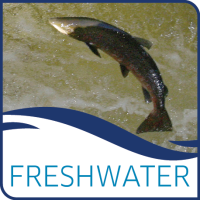The River North Esk enters the North Sea in eastern Scotland. Wild Atlantic salmon (Salmo salar) have been monitored on this river since the 1960s. A proportion of emigrant smolts were captured in a trap on the Kinnaber Mill Lade situated off the lower reaches of the North Esk (WGS N56:44:51, W2:27:16). Weekly counts of captured individuals are provided for the years 1975 - 2013.
Data and Resources
- Kinnaber Mill Trap Smolt Weekly Count 1975-2013csv
Data colums:
Preview Download
- year: (integer) week of smolt trapping
- week: (...
| Field | Value |
|---|---|
| Publisher | |
| Modified | 2021-08-24 |
| Release Date | 2021-08-24 |
| Identifier | 65c256c4-aaa0-4004-8816-692401cafa4d |
| Spatial / Geographical Coverage Area | POINT (-2.4543714523315 56.747136187207) |
| Temporal Coverage | 1975-04-01 to 2013-05-28 |
| Language | English (United Kingdom) |
| License | UK Open Government Licence (OGL) |
| Granularity | Weekly |
| Data Dictionary | A proportion of the smolts emigrating from the river in spring were captured in a fish trap situated in a diversionary lade (~500 m upstream from the tidal limit) as part of a programme to estimate total smolt production. The trap was operated throughout the smolt run between late March and early July each year. The lade diverted a proportion of total emigrant smolts (typically 5% - 10% depending on flow conditions) and the trap was considered to be 100% efficient within the lade except in rare cases of spillage. In autumn 2013, damage to the dyke which diverted water into the lade caused trapping at this facility to be stopped. Weekly counts of smolts at the trap collected between 1975 and 2013 are considered to be robust, with similar levels of effort, and protocols, employed throughout the time series. However, note that the proportion of smolts captured was negatively related to river flow within the season; as this was not corrected for in the data, the weekly counts do not equate to total smolt production. |
| Contact Name | Marine Scotland |
| Contact Email | |
| Public Access Level | Public |


